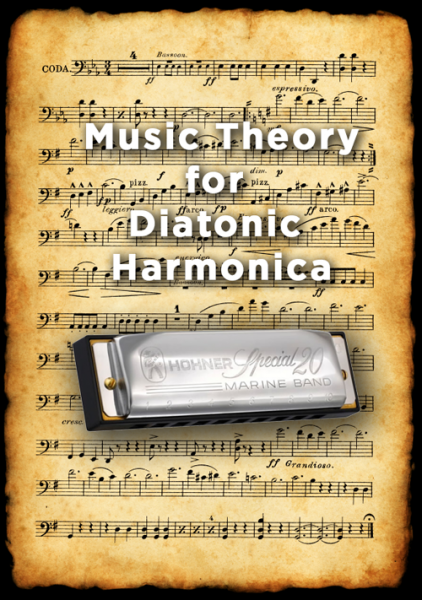Music Theory for Diatonic Harmonica: Part 3

The majority of Americans who play diatonic harmonica are primarily Blues players. This is because the instrument naturally plays Blues chords and licks if you play in the Mixolydian Mode, G on a C harp, also called Cross Harp and Second Position. (Ah, terminology.) This approach was discovered by American Blues musicians sometime in the 1920s or 30s - nobody really knows when. It is an incredible coincidence that the Germans would unknowingly design the world’s greatest Blues instrument, but it’s the truth. It’s just as natural to play a simple Blues chordal vamp on the diatonic harmonica as it is to play a German Folk tune.
And if you have a decent ear and know the Blues, you don’t really need to know music theory or know anything about reading music to play basic Blues on the harmonica. That’s why many Blues harmonica players don’t know the names of the notes they are playing. The C harmonica just naturally plays a G7 chord, and you can play all sorts of chordal Blues vamping patterns just by breathing in and out in time - it’s amazing.
The reason harmonica players call it Second Position is directly related to music theory, specifically the interval of a perfect fifth and the Circle of Fifths, usually used to explain the system of key signatures. If you go up a 5th from C, that is G.
However, since the harmonica can’t play most of the “black keys” without some very special techniques, when one goes up a 5th from C to G and plays in G, the only notes available in G are the “white keys”, which give you the Mixolydian Mode - major scale with a b7. And there is even one note missing in the first octave of Second Position - the A is “not there”. You can only get it by “bending.“
It is not like the bending technique on a guitar where a player pulls or pushes sideways on a string, or a violinist sliding a finger up and down the fingerboard, or the trombone’s slide, or the gradual sliding of fingers over the holes of a flute, or changing the air pressure in your mouth on a wind instrument, etc, etc. On a harmonica, bending a note requires a special technique not used on any other instrument. It involves very specific movements of the tongue, closing the nose, and shaping your mouth in very particular ways. It’s a “feel” that can be only be taught indirectly. The closest thing to it in my experience is learning how to ride a bicycle. Someone tells you the basic idea, you try and try, you can’t do it, and suddenly you’re doing it, and once you can do it, you never forget how.
Once you have figured out how to bend notes on a harmonica, especially the draw notes on the bottom 4 holes and the 6th hole (you can’t bend the 5th hole), you can play about 99% of standard Cross Harp/2nd Position Blues licks. If you don’t know how to bend notes, you can play about 5% of them and will get very frustrated. I can’t think of another instrument where an invisible, intuitive, hard-to-teach skill unlocks the secrets of basic playing.
So how does this whole process of playing Blues on a diatonic harmonica intersect with music theory? Interesting question, and I think the answer is - “it depends on how much you need to know to play with other musicians.”
A lot of Blues players don’t know the names of the intervals or the modal positions (and there are 7 of those). If they have a good ear, listen to a lot of Blues harmonica, and absorb the style - they play what they play, it sounds good, they know enough to figure out which key harmonica to use to play the Blues in this position with other musicians. Pick the harp a 5th below the key of the Blues that you are playing. For example, use a G harp to play Blues in D, a D harp to play Blues in A, a C harp to play the Blues in G.
I try to teach a diatonic harmonica player the music theory he needs to know to function with other musicians, since musicians who play any other instrument ALL know the names of the notes. And most know what notes they are playing, because they are using their fingers/hands to play the notes, and because they can also SEE what they are doing! The more complex the music, the more theory you need to know.
- Howard Levy
ArtistWorks offers a free music theory course to members of all schools taught by Jonathan Coopersmith, Head of the Music Theory Department at Curtis Institute of Music.
Related Blogs:
- Music Theory and the Diatonic Harmonica
- Music Theory with Howard Levy: part 1
- History of Harmonica: Part 1
- History of Harmonica: Part 2
- Interview with Jonathan Coopersmith, Music Theory Department Head at Curtis
- Howard Levy on Why You Should Learn Harmonica
- Interview with Howard Levy
Learn more about online harmonica lessons with Howard Levy at www.artistworks.com/howard-levy








Comments